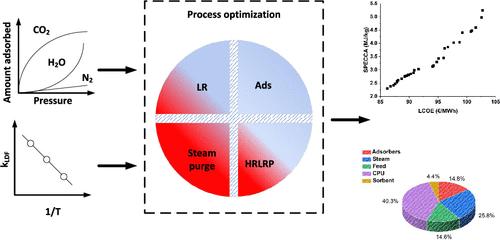Simulation and Optimization of a Rotary Temperature Swing Adsorption (RTSA) Process for CO2 Capture
IF 3.9
3区 工程技术
Q2 ENGINEERING, CHEMICAL
引用次数: 0
Abstract
A rotary temperature swing adsorption process (RTSA) coupled with a cryogenic purification unit (CPU) was evaluated for capturing and concentrating CO2 from the natural gas combustion cycle (NGCC) flue gas. With a Lewatit sorbent, a 4-step RTSA process coupled with CPU was optimized to study the levelized cost of electricity (LCOE) and specific primary energy consumption for CO2 avoided (SPECCA). The RTSA process was able to concentrate the CO2 to 95% on a dry basis, and with the addition of the CPU, the CO2 was concentrated to 100%. From the optimization of the process, the LCOE was found to be 86.2 €/MWh. The SPECCA value was 2.29 MJ/kg. The cost of CO2 avoided was 76.4€/tonne. The LCOE of the RTSA process was 6% lower compared to a fixed bed containing monoliths, while the SPECCA was higher due to the high steam velocities chosen by the optimizer for the RTSA process. For the 4-step TSA process with a steam purge step, nearly 99% of the specific energy consumption was due to the steam generation process.

旋转变温吸附(RTSA) CO2捕集过程的模拟与优化
采用旋转变温吸附工艺(RTSA)和低温净化装置(CPU)对天然气燃烧循环(NGCC)烟气中的CO2进行了捕集和浓缩评价。采用lewait吸附剂,优化了4步RTSA工艺与CPU的耦合,研究了平准化电力成本(LCOE)和二氧化碳减排的特定一次能源消耗(SPECCA)。RTSA工艺能够在干燥的基础上将CO2浓缩到95%,并且在添加CPU后,CO2浓缩到100%。优化后的LCOE为86.2€/MWh。SPECCA值为2.29 MJ/kg。避免二氧化碳的成本为每吨76.4欧元。与含有单体的固定床相比,RTSA工艺的LCOE降低了6%,而由于优化器为RTSA工艺选择了高蒸汽速度,SPECCA更高。对于带蒸汽吹扫步骤的4步TSA工艺,近99%的比能耗来自蒸汽产生过程。
本文章由计算机程序翻译,如有差异,请以英文原文为准。
求助全文
约1分钟内获得全文
求助全文
来源期刊

Industrial & Engineering Chemistry Research
工程技术-工程:化工
CiteScore
7.40
自引率
7.10%
发文量
1467
审稿时长
2.8 months
期刊介绍:
ndustrial & Engineering Chemistry, with variations in title and format, has been published since 1909 by the American Chemical Society. Industrial & Engineering Chemistry Research is a weekly publication that reports industrial and academic research in the broad fields of applied chemistry and chemical engineering with special focus on fundamentals, processes, and products.
 求助内容:
求助内容: 应助结果提醒方式:
应助结果提醒方式:


